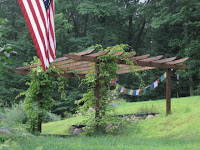I'm still trying to identify the most persistent culprit and not sure if it is a noxious weed or a hearty native. Goatsrue, giant hogweed, oxygen weed, catclaw mimosa, itch grass, tropical soda apple. I didn't know I was supposed to worry about these things taking over my garden. If I had known, my anxiety over weeding would only be surpassed by my drive to cull every turkeyberry or liverseedgrass plant from the garden. The good news is that these noxious weeds can be replaced with interestingly named natives like bladder sedge, rattlesnake fern and nannyberry. The only catch is my inability to identify any of them -- native or noxious.
Perhaps I should spend time communing with the sprays of creeping growth, listening to their wisdom. Bob Cannard has written about a wholistic approach to cultivation, seeking to understand plants and insects as they coexist. I should be learning from the happy, well- established vines in my hillside soil, rather than spending hours bent over futilely pulling against the tensile strength of the buried runners. Snap. Dig. Snap. With every pull, they win, still rooted and ready to send out new shoots.
Why don't these vines understand what I need? At this point I'm a bit jealous of the people living closer to town center on land cultivated since the mid-eighteenth century -- land tamed and trained into lush productivity. Orchards, agricultural fields, grassy meadows for cows to graze. Up here, on Muddy Hill Road, we can dream and compost and bring in yards of soil, mulch and loam. We can raise small livestock for manure. We can rotate crops.
Surrounded by dense forest, there is a limit to what we can cultivate. In the absence of heavy machinery, the forest will always win. Even armed with a chainsaw, I cannot stop the woods. Only persistent labor can keep them at an arbitrary boundary defined by my use of the land. I am a temporary resident and they know it. And so do I.
READ MORE...




